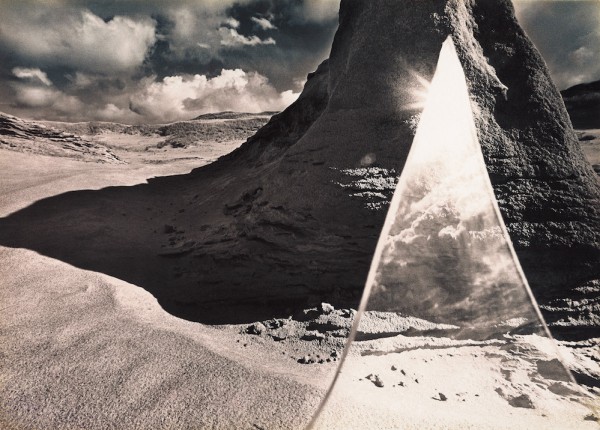
Virgilijus Sonta, Black Hill, 1985
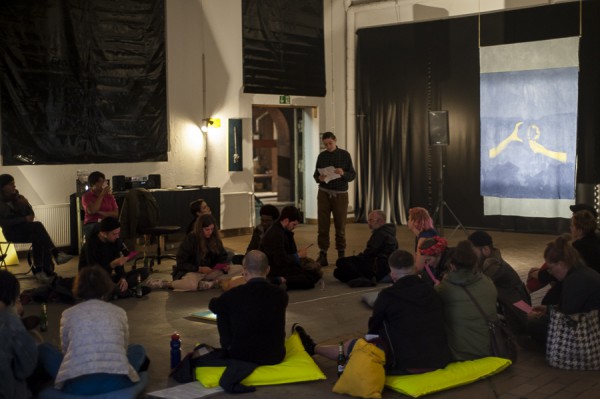
Caspar Heinemann, Pumicestone, reading at the opening of WHEN THE SEA LOOKS BACK. A Serpent's Tale, 19 October 2017, Photo: Emma Haugh
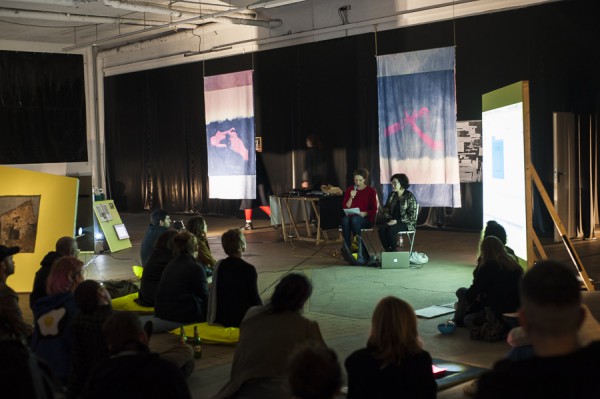
Almagul Menlibayeva and Ulrike Gerhardt, conversation at the opening of WHEN THE SEA LOOKS BACK. A Serpent's Tale, 19 October 2017, Photo: Emma Haugh
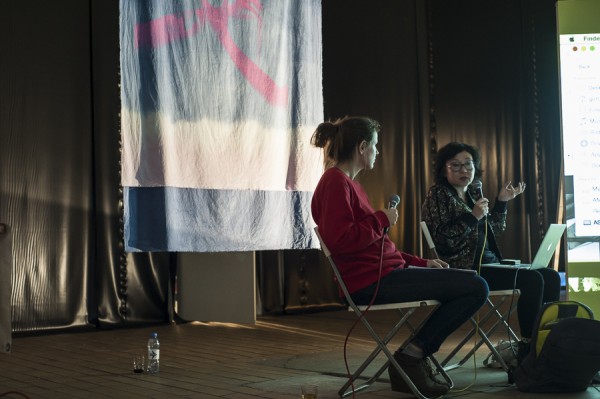
Almagul Menlibayeva and Ulrike Gerhardt, conversation at the opening of WHEN THE SEA LOOKS BACK. A Serpent's Tale, 19 October 2017, Photo: Emma Haugh
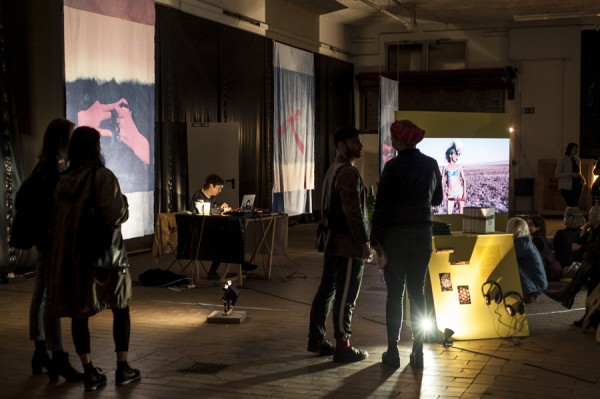
Golden Diskó Ship, music performance at the opening of WHEN THE SEA LOOKS BACK. A Serpent's Tale, 19 October 2017, Photo: Emma Haugh
The Many Headed Hydra #02
Exhibition, evocations, radio magazine
With contributions by Anti*Preuss, Bryndis Björnsdottír, Cooltūristės, Ieva Epnere, Daniel Falb, Sonja Gerdes, Ulrike Gerhardt, Golden Diskó Ship, Caspar Heinemann, Almagul Menlibayeva, Sondra Perry, Ashkan Sepahvand, Virgilijus Šonta, Jessica Lauren Elizabeth Taylor, The Many Headed Hydra, Elsa Westreicher. Curated by Emma Haugh and Suza Husse.
Exhibition 20 October – 16 December 2017
Opening hours of the exhibition
Wednesday to Saturday, 3-7 pm
The skin of the sea returns our gaze with unknown depths, tales of other lands and the movement of peoples. There is always something in the sea that tugs at the salt and water in our bodies, that seduces and alienates us in the same moment. Things we once knew but may have forgotten. Myths offer symbols that fuse our psyche with planetary streams, historical contradictions and kinships.
The Many Headed Hydra is a shape-shifting collective interested in myths and practices of queer ecologies that emerge from bodies of water. Developed with people from different islands, continents and peninsulas, The Many Headed Hydra is a feminist and decolonial art project. Involving research, art making and publishing based on collaboration and modes of storytelling The Many Headed Hydra uses publication as a performative device and surfaces in the form of magazines, evocations and exhibitions.
WHEN THE SEA LOOKS BACK (A Serpent’s Tale) is a polyphonic oracle curated by Emma Haugh and Suza Husse that engages the sea as a mirror and the serpent as a trickster to weave tales from the crossings of landscape and body, technology and power. Looking back with the sea, The Many Headed Hydra fabulates a connection between the desert landscapes of South and North, of the parched Aral Sea and the Curonian ‘dead’ dunes that reaches across the aftershocks of an ecological modernity formed by colonial land use. Through practices from the fields of visual arts, performance, writing, music and philosophy, the oracles in WHEN THE SEA LOOKS BACK tell of diaspora and border cultures in deep time ecologies and of post-imperial interspecies transformations. Following serpentine markings of future, past and present coastlines by way of imagination, memory, oral and visual modes of transmission, WHEN THE SEA LOOKS BACK approaches the waters as historical topographies and political collectivities.
The first iteration of this interdisciplinary project took place across three months at Nida Art Colony on the Curonian Spit this summer. Comprising collaboration with invited artists and co-researchers in residence WHEN THE SEA LOOKS BACK Part 1 was a site specific wild practice in the post-Soviet landscape and in queer dialogue with the popular Lithuanian folk tale Eglė Queen of the Grass Snakes – a story that has migrated across centuries from India via Kazakhstan to Lithuania, to Turkey and to Germany among other places. Looking back with the sea from the Curonian Spit peninsula is to image a forest becoming a sand dune while ships are built from trees to sail between Atlantic shores under an imperial flag. The continuing tension between the desert dunes and the forest is a living trace of entangled histories: the Prussian expansion of colonial sea fare and trade, the replanting of the forest carried out by generations of women while the sea and spit remained borderland claimed by four different nations across two centuries.
For Part 2 at District Berlin the body of the project – from Almagul Menlibayevas interspecies myth makings in the Aralkum desert landscape of ecological trauma to the artistic reponses by Cooltūristės and Bryndis Björnsdottír to the reptile-human and human-tree shape-shifting in Eglė Queen of the Grass Snakes and the tale’s historical relation to migration and nationalized culture, from the afrofuturist flickering of sea, skin and gaze in the abstractions of a body becoming landscape becoming mirror in the work of Sondra Perry to the queer photography created in Nida in the 1970s and 80s by Virgilius Sonta – travels and grows several new heads to speak from the belly of the Hydra to the Berlin context.
The exhibition, evocations and radio magazine at District include new commissions and contributions from Caspar Heinemann, Sonja Gerdes, Ashkan Sepahvand, Jessica Lauren Elizabeth Taylor and Anti*Preuss. The exhibition and program opens with the launch of Hydra Magazine #02, an affair in fragments and sound assembled around an experimental radio magazine on cassette tape developed in response to the project by Golden Disko Ship. The radio magazine that was first broadcasted at the local radio station Neringa FM from Nida Art Colony will be performed as a live concert by Golden Disko Ship for the opening at District.
PROGRAMME
October 19 OPENING
6 pm Exhibition Opening
7 pm Pumicestone
Reading Caspar Heinemann
anarcho communist poet // twinky butch mystic // ex-ex-punk // trans as in transitional demand [berlin, mostly]
„…it is all about contingency or soft water butch or bodies without organs, kettles without limescale, utopian futures etc. […] Global sea level rise is roughly 3 mm a year, which is roughly the amount of blood I contributed, which is roughly biopolitics biopolitics biopolitics.“
angstravaganza.tumblr.com
8 pm After The Aral Sea: Diasporic Dreamscapes in the work of Almagul Menlibayeva
Conversation Ulrike Gerhardt and Almagul Menlibayeva
9 pm When The Sea Looks Back. A Serpent’s Tale – Live Radio Show
Music Performance by Golden Diskó Ship and Launch of The Many Headed Hydra Radio Magazine #02
The imagination, speculation and dissolution of space and time vibrating through and between the works in WHEN THE SEA LOOKS BACK. A Serpent’s Tale can be experienced in sound through Golden Diskó Ship’s field recordings, composing and sampling. From the queer photography of Soviet borderland created in Nida by Virgilijus Šonta to the afrofuturist flickering of sea, skin and gaze in the abstract reflections of body becoming landscape becoming mirror in the work of Sondra Perry, the radio magazine offers a space to listen and even dance to the Many Headed Hydra’s oracles in their eco-historical contexts.
November 18
4 pm Landráð II: Unearthing
Performance by Bryndís Björnsdóttir
November 6
6 – 9 pm Anti*Preuß
Tellings, readings and queerings with The Many Headed Hydra and Joerg Franzbecker
For 10 participants – please register at press@district-berlin.com until November 30, 2017.
December 14
6 – 10 pm Muttererde
Premiere of Jessica Lauren Elizabeth Taylor’s multi-voice video project in collaboration with Astrid Gleichmann featuring Camalo Gaskin, Tobi Ayedadjou, Niv Acosta, Natalie Anguezomo Mba Bikoro, Margaux Coker and Fannie Sosa
A project by Nida Art Colony of Vilnius Academy of Arts and District Berlin. Supported by the Lithuanian Council for Culture & the Lithuanian Ministry of Culture, Goethe Institute Lithuania, the Arts Council of Ireland and the Nordic-Baltic Mobility Programme
The Many Headed Hydra was initiated by artist Emma Haugh and curator Suza Husse in 2016 at District. The Many Headed Hydra Magazine #01: SEA BODY INFRASTRUCTURE IMAGE edited by Emma Haugh and Suza Husse was published in summer 2016 with surfacings in Berlin and Reykjavik. Contributors: Anna Hallin & Olga Bergmann, Bryndís Björnsdóttir, Hannah Black, Natasha Ginwala, Tinna Grétarsdóttir, Emma Haugh, Suza Husse, Occupational Hazard Project, Tejal Shah, Ato Malinda, Nine Eglantine Yamamoto-Masson and participants of the workshops “Speaking As Fishes” in Leipzig and Reykjavík. Published by District Berlin in collaboration with Occupational Hazard Project, Reykjavík.
